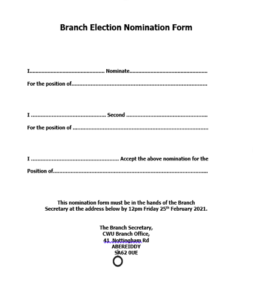Resource: 4 simple steps to stand in a CWU election
As a union we are proud of our democratic traditions. The CWU has always been and will continue to be a union run by its members, for its members. Every CWU member is entitled to stand in an election. If you think you have what it takes, follow these 4 simple steps.
Step One: Identify a position that’s right for you
Your first decision when standing for an elected trade union position is deciding what role you want to stand for.
Many members are familiar with CWU workplace or area representatives. These representatives lead on industrial and health and safety issues and are visible in workplaces, however, there are many other different union positions within branches that members can stand for.
Find out more about the different types of branch roles here.
Step Two: Find out when your next elections are due to take place
Branch elections are governed by the branch model constitution, commonly referred to as the branch rules. These rules have been put in place to ensure all candidates are treated equally and fairly.
Depending on your local branch rules, branch elections can take place annually or bi-annually and may be advertised to the membership via CWU noticeboards, email or by post. All elections must illustrate closing dates.
It is good practice to familiarise yourself with your branch rule book as rules on election processes can vary from branch to branch.
You can obtain a copy of your branch rule book and find out when your next branch elections are by contacting your local branch secretary here.
Step Three: Complete a Nomination form
No member can be elected to a CWU position without first having been nominated in writing by two CWU members from the same branch – one member as a proposer, the other as a seconder and with the candidate’s written consent to the nomination.
Most branch nominations are conducted using a CWU branch nomination form. CWU nomination forms can be obtained via your branch or local CWU representative.
Branch nomination forms can vary in appearance and style but typically look like this:

Once completed all nomination forms must be sent back to your branch or to another designated branch officer (depending on your local election rules) and must be done so before the election closing date.
Step four: Writing an election address
Once you have submitted your nomination most branches require candidates to produce an election address.
An election address is a campaign statement that a candidate makes to persuade members to vote for them at an election and usually has a word count limit of 300 words. Please read our how-to guide here.
The statement provides candidates an opportunity to promote themselves and communicate their reasons for standing for election, for example, what they think they can bring to the position and what goals they hope to achieve in the role.
Writing an election address can be a difficult task, especially if you’re doing it for the first time. The CWU are currently designing a new programme of training workshops to support members through this process.
Please re-visit the page for further information or sign up for training workshops notifications using the sign up toolbar at the top of CWU Unlock homepage.
